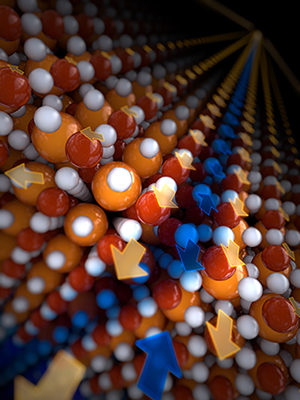ZIAM publication in Nature: Thin film produces new chemistry in ‘nanoreactor’

Physicists at the University of Groningen led by Professor of Functional Nanomaterials Beatriz Noheda have discovered a new manganese compound that is produced by tension in the crystal structure of terbium manganese oxide. The technique they used to create this new material could open the way to new nanoscale devices. Their findings were published on 20 November 2014 in the journal Nature.
The researchers grew very thin layers (no more than a few dozen atoms thick) of the terbium manganese oxide crystal on a thicker base layer of strontium titanium oxide. This base layer affects the growth of the thin layer. When pieces of growing crystal meet, an interface or ‘domain wall’ forms, and the crystal structure develops tensile stress in this wall.
Nanoreactor
Until a few years ago, materials scientists tried to prevent domain walls from occurring when creating very thin layers. ‘Domain walls were seen as defects in the material’, says Noheda. Then it became clear that some domains walls actually invest the material with new properties, and, as has now become apparent, the domain wall can also behave as a nanoscale chemical reactor.
Walls
The Groningen researchers have gained a lot of expertise in controlling how many domain walls develop. The structure of the base layer affects this, for instance, and the thinner the crystal layer, the greater the number of walls that occur. ‘Alongside controlling how many walls develop, a further considerable challenge was to analyse exactly what happens in a wall, as this is generally only one atom thick’, says Noheda.
One way to analyse the material in the wall is to compare samples comprising different numbers of walls. The researchers saw that the more walls there were, the more magnetic the material was. ‘Direct observation of a magnetic response is not yet possible on the atomic scale, particularly not in an insulator’, says Noheda.
Zigzag line
An advanced atomic-resolution chemical analysis was used to show that the composition of the crystal in the walls had changed: in specific locations a manganese atom had taken the place of a larger terbium atom. The terbium atom forms a kind of zigzag line in the crystal structure. Two opposing zigzags meet in the domain wall, thus causing some of the terbium atoms to come into very close proximity. ‘This creates significant tension, the terbium atom disappears from the crystal, and a smaller manganese atom takes its place’, explains Noheda.
New chemistry
In contrast to the normal crystal, this extra manganese makes the wall magnetic. Professor of Theoretical Physics Maxim Mostovoy of the University of Groningen modelled the magnetism, and his results match the results of the experiment: ‘A bond that has not yet been described occurs between five manganese atoms. We therefore see new chemistry in the domain wall.’
This makes the domain wall a kind of nanoscale chemical reactor. ‘And we suspect that this kind of new bond will occur in all crystals with this zigzag structure.’ Noheda hopes in further research to generate walls with the potential to form circuits. Minute circuits of only a few atoms in size could then develop. ‘But I also hope that chemists will set to work on these nanoreactors.’
ZIAM
Beatriz Noheda and Maxim Mostovoy both work at the Zernike Institute for Advanced Materials (ZIAM), part of the University of Groningen’s Faculty of Science and Engineering. The Zernike Institute is a top national research institute.
Noheda’s research is funded by NanoNextNl, a consortium of 130 partners including universities, members of the business community and the authorities who collaborate in the field of microtechnology and nanotechnology, and by FOM, the Foundation for Fundamental Research on Matter.
Artificial chemical and magnetic structure at the domain walls of an epitaxial oxide S. Farokhipoor, C. Magén, S. Venkatesan, J. Íñiguez, C.J.M. Daumont, D. Rubi, E. Snoeck, M. Mostovoy, C. de Graaf, A. Müller, M. Döblinger, C. Scheu and B. Noheda
The article will be accompanied by a ‘News and Views’ section discussing the results of the new research.
For further information please contact Prof. Beatriz Noheda
| Last modified: | 09 February 2017 2.55 p.m. |
More news
-
24 March 2025
UG 28th in World's Most International Universities 2025 rankings
The University of Groningen has been ranked 28th in the World's Most International Universities 2025 by Times Higher Education. With this, the UG leaves behind institutions such as MIT and Harvard. The 28th place marks an increase of five places: in...
-
05 March 2025
Women in Science
The UG celebrates International Women’s Day with a special photo series: Women in Science.
-
16 December 2024
Jouke de Vries: ‘The University will have to be flexible’
2024 was a festive year for the University of Groningen. In this podcast, Jouke de Vries, the chair of the Executive Board, looks back.
